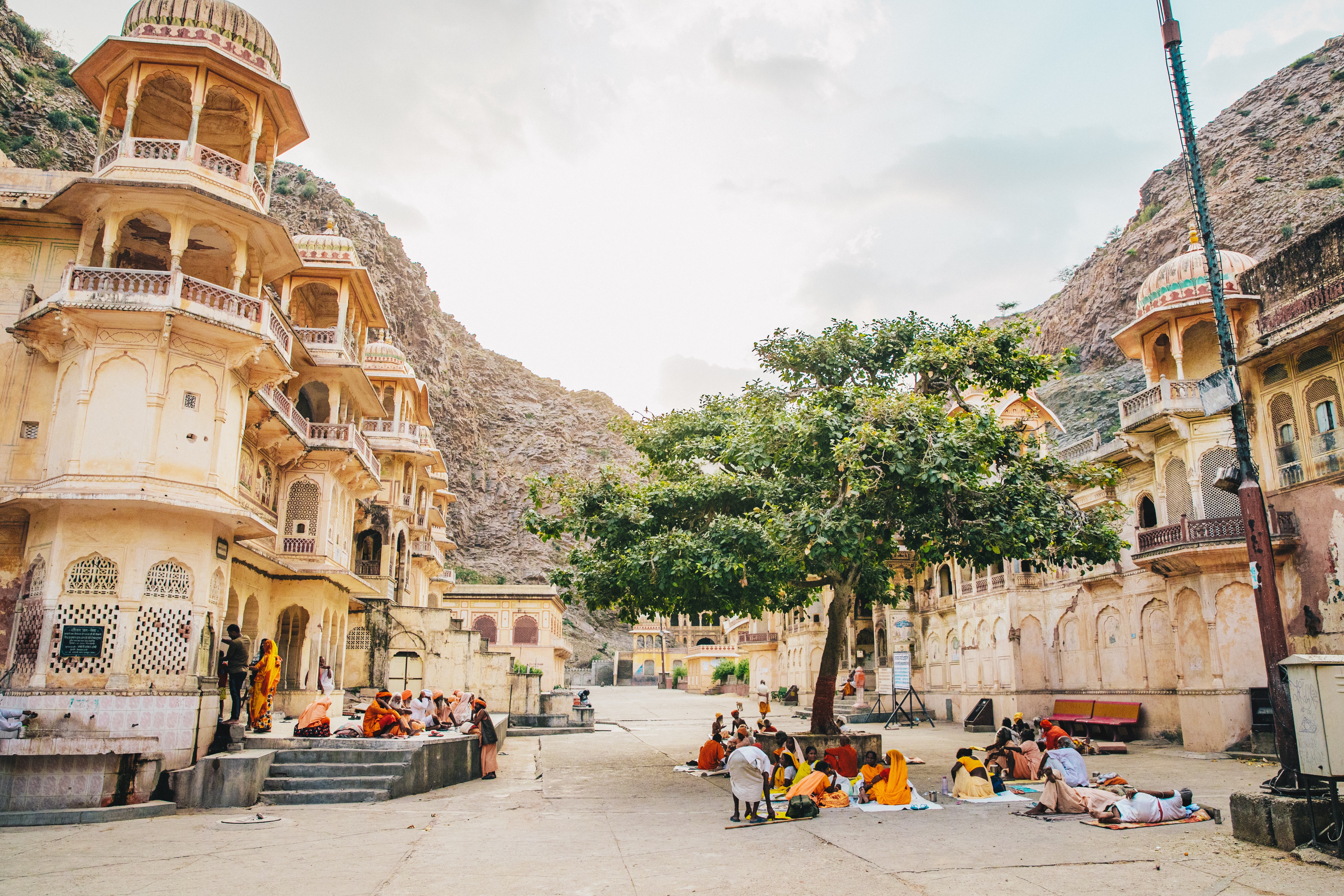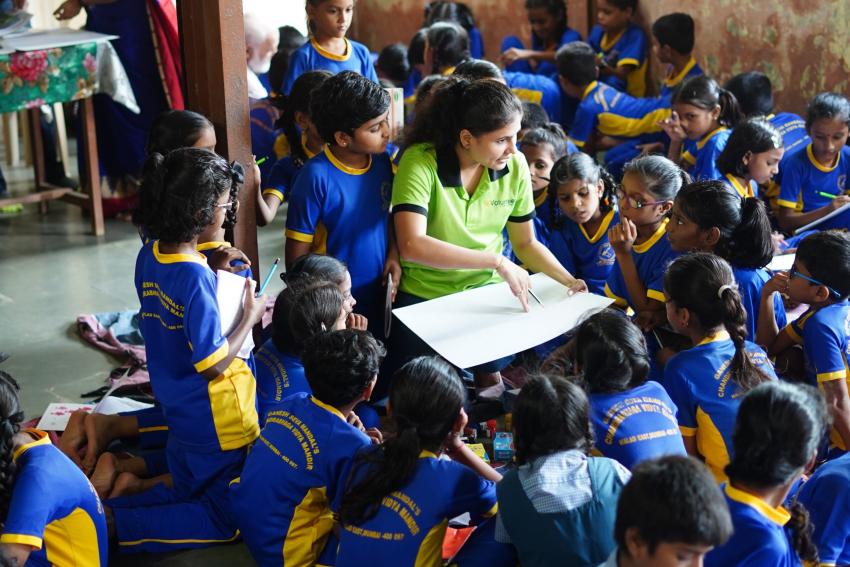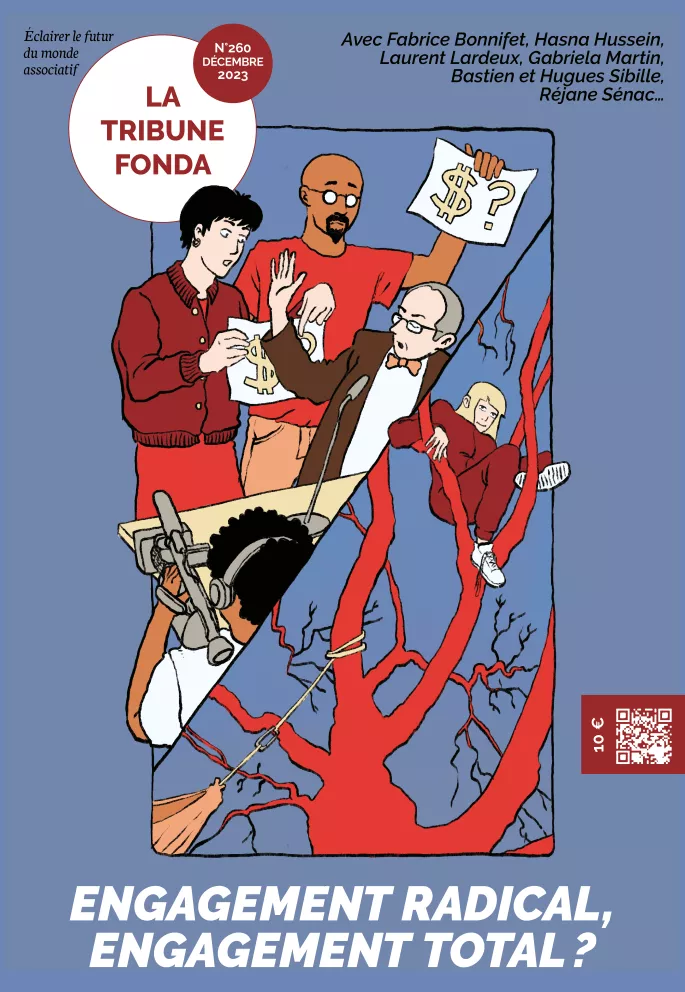Shalabh Sahai is answering Stephanie Andrieux’s questions.
What's the story behind IVolunteer?
Shalabh Sahai: I met my cofounders at the Institute of Rural Management of Anand (IRMA) back in 1998. We were studying rural and social development, and we soon realized that the nonprofit sector was running short of people. In the 1990s, India saw a boom in its economy, primarily thanks to its human capital. We wondered: what if the human capital that was powering the Indian economy could also be leveraged to power the nonprofit sector?
We started studying the market, and we realized that no organization looked at volunteering countrywide and in a modern way. We were in the IT boom time, so we immediately thought of establishing an internet-based platform that would connect people to organizations that wanted volunteers. That's how IVolunteer was born in 2001. We quickly moved from a platform to on-ground programs. Our flagship program - iVolunteer enters in the seven big cities in India, including Delhi and Mumbai.
How has the work evolved?
During this 20-year journey, we have gone through four major phases of evolution. First, we began with the idea to establish a monster.com1 kind of platform to connect the volunteers to nonprofits. Within the first two years, we realized that it wasn't working out. Many people showed interest but there was almost no volunteering happening on the ground. So we moved into helping organizations understand how to involve these new-age volunteers. I call them new-age volunteers because, until the 2000s, the Indian volunteers were mainly homemakers, senior citizens, or university students. Our platform was online, and most of our volunteers were accessing it from their workspaces. We were targeting a new segment of the population.
We quickly realized that working volunteers changed the nature of volunteering. Our second phase started when we moved to workspace-focused programs. We both helped salaried people to volunteer and nonprofits to understand how to engage people with high skills, but constrained time availability.
Our work then evolved -that's the third phase- into skills-based volunteering. From 2010 onwards, corporate volunteering started picking up. And so our programs evolved into supporting corporations who were setting up their employee-volunteer policies. This got a major boost when the new CSR Act of 2013 wherein the government legally mandated the corporates for CSR programs. Though employee volunteering is not directly covered under the Act, it does get a lot of corporates deeply interested.
Today we are in a fourth phase in which we focus on helping volunteers grow from their experience. We started 2 years ago by running surveys to ask people what kind of experience they'd had, and what they had learned by volunteering. Also, at the end of any volunteer activity, we spend some time on self-reflection. What do they feel about that impact? Did they identify other actions that are needed? What role could they play in it? We need to show the significant impact of volunteering on the volunteer : that's the only way lasting change can happen for Indians and India. The positive change that a volunteer undergoes is beneficial to the volunteer supporting organization (employer/institute) and in the long run builds an empathetic, caring and responsible society.
IVolunteer is based in seven big cities in India: Delhi, Mumbai, Chennai, Bangalore, Hyderabad, Kolkata, and Pune.
India is such a large country, each of these cities has significantly different socio-cultural dynamics. Instead of structuring programs nationwide, IVolunteer experience in each city different programs, and local teams decide later what is appropriate for their community.
How do you help organizations to work with volunteers?
As I said, we began from a platform approach, in which organizations would put across their requirements. However, we realized that often nonprofits do not think of how they can leverage volunteers, or even engage them. So a good part of our work was to help them think through what kind of volunteering they needed. We ran region-wise volunteer management workshops until seven years back. Now, we do it on a demand basis. For example, the Confederation of Indian Industries (CII) asks us to organize workshops on volunteer management for their NGO partners or corporate members.
In the last three years, we have also been partnered with some institutes working on rural development. We helped social work colleges design volunteer management workshops or run full-credit courses. It is important for people who are getting trained in social work to also get trained in volunteer management. The demand for these services has been increasing.
Can you tell us a little bit about your youth programs? Is that a new area of work for iVolunteer?
E=Back in 2004, we started a summer fellowship program for university students which evolved into present 1.5 year long India Fellows (started in 2010) program for 21 to 28 year-olds. A year and a half back when we launched a specific fellowship with the JSW Foundation2 focused on working alongside CSR programs. Young Indians are driven by society to certain career paths. So 18 to 25-year-olds usually don't make their own choice, they do what society or their families expect them to do - which usually does not include a social sector career. We, at IVolunteer, believe that if young people are exposed to the development sector, they can make a conscious choice about their possible involvement in it.
Through our fellowship programs, we provide youth the opportunity to discover nonprofits from within. And while they contribute during the fellowship program, they learn a lot about themselves and how they can contribute throughout their lifetime to the social sector. We believe that if you show people the challenges of the social sector, they will keep engaging with it, even if they don't choose to make a career out of it. Whether they become businessmen, lawyers, or public administrators, they will be much more conscious as leaders. If we inspire the right leaders for tomorrow, then we can make a lasting impact.
We also started more recently school-based volunteering activities in Chennai. During the COVID pandemic, we were approached by local schools who wanted their students to learn about civic engagement. We drafted a program for pupils from the age of 8 years old to about 15 years old. It started with taking care of things around your classroom, around your home, or in your neighborhood. We staggered the levels of engagement depending on the age group.
We have also started recently another engagement program in Chennai with a private university. We are trying to establish an IVolunteer club, in which students can structure their volunteering. We only provide them an outside support, instead of telling them what to do. We're still learning over there.
Do Indian students get credit for volunteering?
No, we don't have a credit system for volunteering in India. The National Service Scheme (NSS) has been active since the 1950s3 through Universities and students get some benefits, but not like credits as practiced in the Western countries. In a way, it is the largest volunteering program as almost 4 million students are part of the NSS4. It's a nationwide program, but it is unequally implemented.
What's the typical profile of a volunteer in India today?
Today the volunteering pool is much wider. Indeed, anybody can volunteer!
But I would say the typical age profile will be between 18 to 45 years old. It includes the 18 to 23 years olds who are mostly in colleges or universities, and then the 23 to 45, who are of active working age. Beyond 50, volunteering is limited not by the will of the senior citizens but by their lack of mobility. In big cities like Delhi or Mumbai, it's not easy for people to go around.

You did mention that before 2000, senior citizens would volunteer more. So that has changed?
Yes, but only as a percentage. It has reduced because the other parts grew quite a lot. People who wanted to volunteer earlier have continued to do so, while the amount of senior volunteers has not grown at the same pace.
What do people mobilize for?
Children have been the favorite cause for quite a long time, especially in the main cities. It's mainly because it is right under everyone's eyes: people walking down the streets are confronted every day with homelessness, street dwelling or even begging. Seeing children on the street has quite a big emotional appeal, so children's causes have always attracted more volunteering, especially education.
What has grown significantly over the last 10-15 years is the interest in environmental-based volunteering. Even more recently, in the last 5-10 years, animal welfare has also seen a significant rise in terms of volunteers. IVolunteer did not work on animal welfare until recently, we started given the demand expressed by volunteers themselves.
In terms of popularity, we can classify children being the most popular cause, then education, and environment, followed by civic engagement in general, and animal welfare. Health related volunteering is, somehow, less popular Civic engagement could be defined as clearing up shared spaces.
You would not count cleaning up as environmental?
No, because people mostly don't do it for environmental reasons, but because it's a space that they use. Many cleanups are paintings of public walls, or cleaning up of public spaces.
Does volunteering cut across the various societal layers in India?
My take on this would be more anecdotal than empirical, but I feel that volunteering is cutting across different communities.
In India, almost 60% of the population resides in villages5.
Over there, people do participate in civic service, but it is not called volunteering. The same dynamic can be observed in low-income urban communities. So if you were to look at purely statistics, volunteering might come across as a high-income urban activity when in fact you are just looking at the privilege to call your actions volunteering.
It is flagrant on DaanUtsav, the seven-day festival of giving that's celebrated around Gandhi's birth centenary, from October 2nd to October 8th6. During DaanUtsav, you will see many people from the lower socioeconomic income strata volunteer, for example, rickshaw drivers. It is one example of people volunteering but not using the term.
You created the first organization devoted to enhancing volunteer engagement in India 20 years ago. Have you seen the sector evolve?
Yes, the sector evolved in a major way. In 2001, we had to explain to people what is volunteering. Nowadays, we don't need to explain it at all. For me, one of the biggest evidence of volunteering's evolution in India is that for the first eight years, we were the only organization operating like this in India. Today, IVolunteer faces quite a competition, a healthy one. The existence of so many organizations supporting volunteering is proof that the overall market size of volunteering has grown.
What would be the next steps to develop volunteering in India?
The first would be a national policy on volunteering. Over the last couple of years, the government has started taking some action, including a government-sponsored platform for corporate volunteering. Yet, no policy or law promotes or supports volunteering. Today, volunteering is a part of the Ministry of Sports and Youth Affairs, which means that volunteering is assumed to be only a youth thing.
The next possible action would be specifically targeted at student volunteering. A credit system would be extremely useful to push volunteering forward.
The third possible action is linked to our Corporate social responsibility (CSR) law, which is unique worldwide7. The Indian law ensures that corporations give funds to the nonprofit space. Yet, it does not include support for volunteering. And that's primarily because the value of volunteering is not quantified at a national level. Quantifying the value of volunteering is the first step to include it in the CSR law.
If we can quantify the contribution of volunteering as part of GDP, we will be able to show the role volunteers play in a country, in a society. Maybe volunteering could become a part of national surveys or the census. If it is talked about, seen, or recognized, it develops. Volunteering is definitely growing in India.
- 1Monster.com is a global employment website that was established in 1999. Claiming to serve more than 70 million job seekers in 2022, the website has been rebranded as foundit‧in in 2023, only in India, South East Asia, and the Middle East.
- 2JSW Foundation is the social development arm of the US$ 13 billion JSW Group, one of India's leading business houses.
- 3The National Service Scheme, known as the NSS, is an extension of activities to the higher education system to orient the student youth to community service while they are studying in education institutions. It is operated by the Ministry of Youth Affairs & Sports.
- 4According to the National Service scheme's figures, more than 3,8 million volunteers enrolled till March 31, 2023.
- 5C. Chandramouli (Office of the Registrar General & Census Commissioner) "Rural-Urban Distribution of Population India", Census Digital Library, 2011. The latest Indian Census dates back to 2011. The 16th Indian Census, initially the 2021 Census of India, has been postponed until after the 2024 general elections.
- 6Contrary to Martin Luther King Day in the United States, DaanUtsav is neither owned by any organization nor supported by the government.
- 7In 2013, India enacted a pioneering mandate that required companies above a certain size, revenue or profit threshold to invest 2% of their net profits on corporate social responsibility (CSR) projects every year.


